Trees Birds Mammals Fish Amphibians Reptiles
Wild Algarve
Bookshop
Hygrophorus latitabundus Britzelm. - Ebony Woodwax
Phylum: Basidiomycota - Class: Agaricomycetes - Order: Agaricales - Family: Hygrophoraceae
Distribution - Taxonomic History - Etymology - Identification - Culinary Notes - Reference Sources
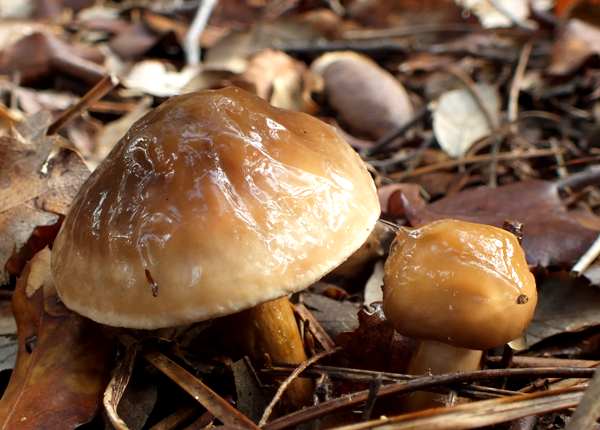
A woodwax of pine plantations and pine-oak mixed woodlands in central and southern Europe, this mycorrhizal mushroom is very slimy in wet weather and remains very sticky for quite a time after rain.
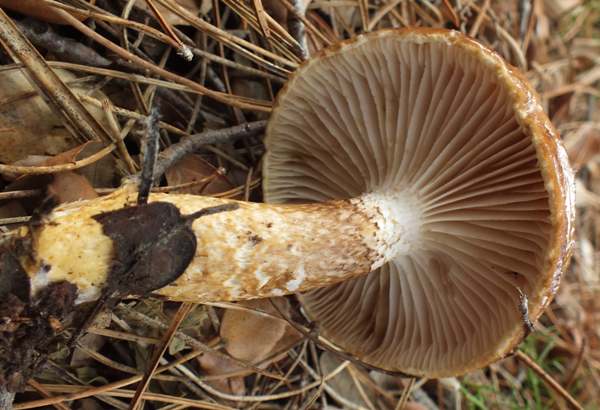
Distribution
Hygrophorus latitabundus is an uncommon to rare find in parts of mainland Europe including parts of Germany and Austria, France, Slovenia, Italy, Greece, Turkey, Spain and Portugal. Apart from a few dubious and unsubstantiated ancient claims, this woodwax mushroom is not authentically recorded in Britain and Ireland.
Taxonomic history
The basionym of this species was established in 1899, when German naturalist Max Britzelmayr (1839 - 1909) gave it the binomial scientific name Hygrophorus latitabundus by which it is generally known today.
Synonyms of Hygrophorus latitabundus include Hygrophorus olivaceoalba var. obesus (Bres.) Rea.
Etymology
Hygrophorus, the genus name, comes from hygro- meaning moisture, and -phorus meaning bearer; not only do these fungi contain a lot of water (as do most other mushrooms, of course) but they are also moist and sticky or slimy.
The specific epithet latitabundus comes from Latin and may be a combination of latit- (the meaning is obscure) and -abundus meaning abundant or plentiful. The one thing this woodwax mushroom has an abundance of it slime, which covers the cap and stem. Another suggestion, from Pietro Curti, is that latitabundus means hiding (in the sense of difficult to find). Any other suggestions?
Identification guide
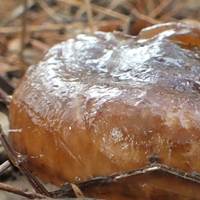 |
Cap
Initially convex, expanding to become almost flat with an inrolled margin and a broad low umbo, sometimes within a broad central depression; surface smooth, grey-brown, reddish brown or olivaceous at the margin and increasingly blackish-brown towards the centre of the cap. Very slimy when wet, remaining glutinous for a long time in dry weather. 3 to 12cm across when fully mature. The cap flesh is white. |
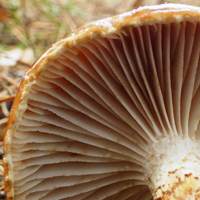 |
Gills
Waxy, arched, weakly decurrent, and moderately spaced; white when young, gradually becoming flecked with brown.
Stem
White with reddish brown fibrils near the cap, but paler towards the stem base; slightly fusiform, (thickened slightly just below the middle then narrowing again towards the base); slimy; 4 to 12cm long, 1 to 3cm in diameter. The stem flesh is firm and whitish. (The stem flesh turns rusty orange-yellow with KOH). |
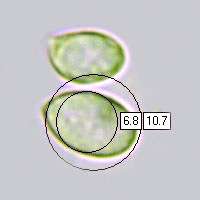 |
Spores
Ellipsoidal, smooth, 7.8-11.4 x 5.1-7.5µm.
Spore print
White. |
Odour/taste |
Odour faintly mushroomy; taste mild. |
Habitat & Ecological role |
Ectomycorrhizal, found under pine trees; favouring calcareous soils |
Season |
Autumn in central Europe; November to January in southern Portugal. |
Similar species |
Herald of Winter, Hygrophorus hypothejus, has a brownish cap but is distinguished by its distant yellow gills and yellowish stem. |
|
Culinary Notes
This uncommon woodland mushroom is reported to be edible once the slimy cap cuticle has been removed. We have no recipes for this species.
Reference Sources
Fascinated by Fungi, 2nd Edition, Pat O'Reilly 2016, reprinted by Coch-y-bonddu Books in 2022.
AMINT (Fungi of Italy) Hygrophorus latitabundus (in Italian)
Dictionary of the Fungi; Paul M. Kirk, Paul F. Cannon, David W. Minter and J. A. Stalpers; CABI, 2008
Taxonomic history and synonym information on these pages is drawn from many sources but in particular from the British Mycological Society's GB Checklist of Fungi.
Top of page...
Fascinated by Fungi. Back by popular demand, Pat O'Reilly's best-selling 450-page hardback book is available now. The latest second edition was republished with a sparkling new cover design in September 2022 by Coch-y-Bonddu Books. Full details and copies are available from the publisher's online bookshop...